Southwest Airlines Flight 1380
Southwest Airlines Flight 1380 was a Boeing 737-7H4 that experienced a failure in the left CFM56-7B engine after departing from New York–LaGuardia Airport en route to Dallas Love Field on April 17, 2018. The engine cowl was broken in the failure and cowl fragments damaged the fuselage, causing rapid depressurization of the aircraft after damaging a cabin window. Other fragments caused damage to the wing. The crew conducted an emergency descent and diverted to Philadelphia International Airport. One passenger was partially ejected from the aircraft and later died. Eight other passengers received minor injuries. The aircraft was substantially damaged.[2][3][4]
.jpg) N772SW, the aircraft involved in the accident photographed in 2013 | |
| Accident | |
|---|---|
| Date | April 17, 2018 |
| Summary | Engine failure leading to rapid depressurization |
| Site | Over Pennsylvania, United States[1] |
| Aircraft | |
| Aircraft type | Boeing 737-7H4 |
| Operator | Southwest Airlines |
| IATA flight No. | WN1380 |
| ICAO flight No. | SWA1380 |
| Call sign | Southwest 1380 |
| Registration | N772SW |
| Flight origin | LaGuardia Airport, New York City, New York, United States |
| Destination | Dallas Love Field, Dallas, Texas, United States |
| Occupants | 149 |
| Passengers | 144 |
| Crew | 5 |
| Fatalities | 1 |
| Injuries | 8 |
| Survivors | 148 |
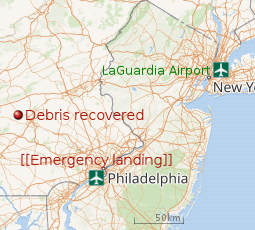 |
This accident was identical to the accident suffered 20 months earlier by Southwest Airlines Flight 3472 flying the same aircraft type, with the same engine type. After that accident, the engine manufacturer, CFM, issued a service directive calling for ultrasonic inspections of the turbine fan blades, with certain serial numbers, service cycles, or service time. Southwest did not do this as this engine was not within the parameters specified by the directive.[2]
It was the first fatal airline accident involving a U.S. passenger carrier since the crash of Colgan Air Flight 3407 in February 2009, and the first aircraft accident involving Southwest Airlines that resulted in the death of a passenger.
Background
Flight 1380 was a regularly scheduled passenger flight from New York-LaGuardia Airport to Dallas Love Field.[3] The aircraft was a Boeing 737-7H4[lower-alpha 1] with the registration N772SW, in service with Southwest Airlines since its manufacture in 2000.[5] It was powered by CFM56-7B engines.[2][3]
Tammie Jo Shults, a former United States Navy fighter pilot, was the captain of the flight;[6] while Darren Ellisor, a former United States Air Force pilot with experience in the Boeing E-3 Sentry,[7] was the first officer.[8] Captain Shults had been with Southwest Airlines since 1994 and had logged a total 11,715 flight hours, including 10,513 hours on the Boeing 737. First officer Ellisor had been with the airline since 2008 and had 9,508 flight hours, with 6,927 of them on the Boeing 737.[2]:7–9 There were 144 passengers and a total of five crew members on board.[2][3]
Accident
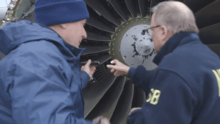

At 11:03 Eastern Daylight Time, the aircraft was at about flight level 320 (a pressure altitude of 32,000 feet (9,800 m)) and climbing when the left engine failed. As a result, most of the engine inlet and parts of the cowling broke off. Fragments from the inlet and cowling struck the wing and fuselage and broke a window in the passenger compartment, which caused rapid decompression of the aircraft. The flight crew conducted an emergency descent of the aircraft and diverted it to Philadelphia International Airport. One passenger sitting next to the broken window suffered fatal injuries, and eight passengers sustained minor injuries. The aircraft sustained substantial damage.[3]
The flight crew stated that the departure and climb from LaGuardia were normal with no indications of any problems; the first officer was flying and the captain was monitoring. They reported that the aircraft yawed and set off several cockpit emergency alarms; a "gray puff of smoke" appeared and the aircraft's cabin suddenly lost air pressure. The flight crew donned their emergency oxygen masks, and the first officer began the emergency descent. The flight data recorder showed that the left engine's performance parameters all dropped simultaneously, vibration became severe, and, within five seconds, the cabin altitude alert activated. The data recorder also showed that the aircraft rolled left by about 40 degrees before the flight crew was able to counter the roll. The flight crew reported that the aircraft was very difficult to control throughout the remainder of the flight because of the extensive damage. The captain took over flying the plane and the first officer carried out the emergency checklist. The captain asked the air traffic controller for a course diversion. She initially requested a course to the nearest airport, but then decided that the airport in Philadelphia was best equipped for this aircraft's emergency. The controller quickly provided vectors to the Philadelphia airport. The flight crew reported initial communications difficulties because of the loud noises, distraction, and wearing oxygen masks, but, as the aircraft descended, communications improved. The captain initially planned on a long final approach to make sure the crew completed all the emergency checklists. However, upon learning of the passengers' injuries, she decided to speed up the approach and expedite landing.[3]
Three flight attendants were assigned to the flight, and another Southwest Airlines employee was a passenger. All four reported that they heard a loud sound and felt severe vibration. The oxygen masks automatically deployed in the cabin. The flight attendants retrieved portable oxygen bottles and began moving through the cabin to assist passengers with their oxygen masks. As they moved toward the mid-cabin, they found a passenger in row 14 sucked part way out the broken window; with the help of two passengers, flight attendants pulled the victim inside the aircraft,[3] and other passengers performed emergency cardiopulmonary resuscitation.[9] The passenger died after being admitted to a local hospital for treatment from the injuries she suffered in the aircraft.[10]
Investigation
Initial investigation
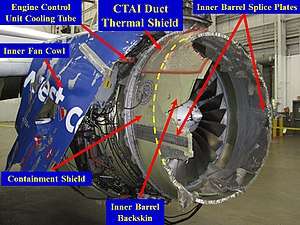

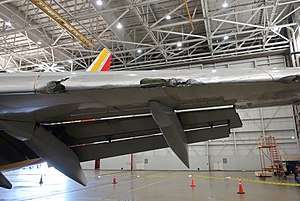
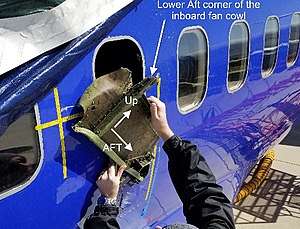
The participants in the investigation included the National Transportation Safety Board (NTSB),[11] the United States Federal Aviation Administration (FAA), Boeing, Southwest Airlines, GE Aviation, the Aircraft Mechanics Fraternal Association, the Southwest Airlines Pilots’ Association, the Transport Workers Union of America, and UTC Aerospace Systems.[3] Because the manufacturer of the failed engine – CFM International (CFM) – is a US-French joint venture, the French Bureau of Enquiry and Analysis for Civil Aviation Safety (BEA) also contributed investigators.[12] Technical teams from CFM[13] assisted with the investigation as well. The NTSB expected the investigation to take 12 to 15 months.[14]
NTSB investigators analyzed a recording of the air traffic radar plots and observed that the radar had shown debris falling from the aircraft, and used wind data to predict where ground searchers could find it.[15] Parts from the engine's nacelle were found in the predicted area at several locations near the town of Bernville, Berks County, Pennsylvania,[1] some 60 miles (100 km; 50 nmi) northwest of Philadelphia.[16][17]
On April 20, 2018, CFM issued Service Bulletin 72-1033, applicable to the CFM56-7B-series engine,[3][18] and on the same day the FAA issued Emergency Airworthiness Directive (EAD) 2018-09-51[19] [20] based on it. The CFM service bulletin recommended ultrasonic inspections of all fan blades on engines that have accumulated 20,000 engine cycles and subsequently at intervals not to exceed 3,000 engine cycles. The EAD required CFM56-7B engine fleet fan blade inspections for engines with 30,000 or greater cycles, within 20 days of issuance, per the instructions provided in the service bulletin, and if any crack indications were found the affected fan blade must be removed from service before further flight. This directive was issued as a one time inspection requirement.[19] On the same day, European Aviation Safety Agency (EASA) also issued EAD 2018-0093E[21] (superseding EASA AD 2018-0071) that required the same ultrasonic fan blade inspections to be performed.[3] The engine manufacturer estimated the new directive affected 352 engines in the US and 681 engines worldwide.[19]
On April 23, 2018, Southwest Airlines announced that it was voluntarily going beyond the FAA EAD requirement and performing ultrasonic inspections on all CFM engines in its fleet, including two each on approximately 700 Boeing 737-700 and 737-800 aircraft.[22]
On April 30, 2018, the aircraft involved in the accident was released by the NTSB, and was flown by Southwest Airlines to a service facility performing major services on Boeing aircraft at Paine Field in Everett, Washington for repairs.[23]
On May 2, 2018, the FAA issued a follow up Airworthiness Directive (AD), 2018-09-10,[24] which expanded the inspections on CFM56-7B engines beyond the original EAD 2018-09-51. The new AD required inspections of engines with lower cycles, and introduced repeat inspection requirements as well. Effective with the issuance of this AD, operators are required to perform detailed inspections on each fan blade before the fan blade accumulates 20,000 cycles since new, or within 113 days, whichever occurs later. If cycles since new on a fan blade is unknown, then the airline is to perform an initial inspection within 113 days from the effective date of this AD. Thereafter, repeat this inspection no later than 3,000 cycles since the last inspection. If any unserviceable fan blade is found, it must be removed from service before further flight. The FAA estimates this AD affects 3,716 engines installed on aircraft of U.S. registry at an estimated cost of US$8,585 per blade replacement.
On June 7, 2018, the aircraft involved in the accident was flown from a service facility performing major services on Boeing aircraft at Paine Field in Everett, Washington to Southern California Logistics Airport in Victorville, California for storage. As of April 2020, the aircraft has not been flown.[25]
Preliminary findings
On May 3, 2018, the NTSB released an investigative update with preliminary findings:[3]
- Initial examination of the aircraft revealed that the majority of the inlet cowl was missing, including the entire outer barrel, the aft bulkhead, and the inner barrel forward of the containment ring. The inlet cowl containment ring was intact but exhibited numerous impact witness marks. Examination of the fan case revealed no through-hole fragment exit penetrations; however, it did exhibit a breach hole that corresponded to one of the fan blade impact marks and fan case tearing.
- The No. 13 fan blade had separated at the root; the dovetail remained installed in the fan disk. Examination of the No. 13 fan blade dovetail exhibited features consistent with metal fatigue initiating at the convex side near the leading edge. Two pieces of the fan blade were recovered from within the engine, between the fan blades and the outlet guide vanes. One piece was part of the blade airfoil root that mated with the dovetail that remained in the fan disk; it was about 12 inches (30 cm) spanwise and full width and weighed about 6.825 pounds (3.096 kg). The other piece, identified as another part of the airfoil, measured about 2 inches (5 cm) spanwise, appeared to be full width, was twisted, and weighed about 0.650 pounds (0.295 kg). All the remaining fan blades exhibited a combination of trailing edge airfoil hard body impact damage, trailing edge tears, and missing material. Some also exhibited airfoil leading edge tip curl or distortion. After the general in situ engine inspection was completed, the remaining fan blades were removed from the fan disk and an ultrasonic inspection was performed, with no other cracks found.
- The No. 13 fan blade was examined further at the NTSB Materials Laboratory. The fatigue fracture propagated from multiple origins at the convex side and was centered about 0.568 inches (14.43 mm) aft of the leading edge face of the dovetail and was located 0.610 inches (15.49 mm) outboard of the root end face. The origin area was located outboard of the dovetail contact face coating, and the visual condition of the coating appeared uniform with no evidence of spalls or disbonding. The fatigue region extended up to 0.483 inches (12.27 mm) deep through the thickness of the dovetail and was 2.232 inches (5.669 cm) long at the convex surface. Six crack arrest lines (not including the fatigue boundary) were observed within the fatigue region and striations consistent with low-cycle fatigue crack growth were observed.
- The accident engine's fan blades had accumulated more than 32,000 engine cycles[lower-alpha 2] since new. Maintenance records showed that the fan blades had been periodically lubricated as required, and that they were last overhauled 10,712 engine cycles before the accident. At the time of the last blade overhaul (November 2012), they were inspected using visual and fluorescent penetrant inspections. After an August 27, 2016, accident in Pensacola, Florida, in which a fan blade fractured, eddy current inspections were incorporated into the overhaul process requirements. In the time since the fan blades' overhaul, the blade dovetails had been lubricated six times. At the time each of these fan blade lubrications occurred, the fan blade dovetail was visually inspected as required.
- The remainder of the airframe exhibited significant impact damage to the leading edge of the left wing, left side of the fuselage, and left horizontal stabilizer. A large gouge impact mark, consistent in shape to a recovered portion of fan cowl and latching mechanism, was adjacent to the row 14 window, which was missing. No window-, structural-, or engine material was found inside the cabin.
NTSB investigative hearings
The NTSB held an investigative hearing on November 14, 2018.[27][28][29] At the hearing, FAA Transport Standards Branch representative Victor Wicklund stated that the production inlets were not required to be subjected to certification testing, but if they had been and had failed, as was the case in this accident, that it would constitute a certification failure. He indicated that the cowling may require design changes.[28]
The NTSB held a second investigative hearing on November 19, 2019.[30] The NTSB also issued seven safety recommendations to the FAA.[31]
Final report
On November 19, 2019, following the aforementioned hearing. The NTSB released the final report on the accident.[2] the probable cause reads:
The National Transportation Safety Board (NTSB) determines that the probable cause of this accident was a low-cycle fatigue crack in the dovetail of fan blade No. 13, which resulted in the fan blade separating in flight and impacting the engine fan case at a location that was critical to the structural integrity and performance of the fan cowl structure. This impact led to the in-flight separation of fan cowl components, including the inboard fan cowl aft latch keeper, which struck the fuselage near a cabin window and caused the window to depart from the airplane, the cabin to rapidly depressurize, and the passenger fatality.
Reactions

On the day of the incident, Elaine Chao, the United States Secretary of Transportation, made a statement to "commend the pilots who safely landed the aircraft, and the crew and fellow passengers who provided support and care for the injured, preventing what could have been far worse."[32] Shortly thereafter, Martha McSally, then a member of the United States House of Representatives from Arizona, introduced a resolution in Congress commending Captain Shults.[33]
On May 1, 2018, US President Donald Trump welcomed the crew members and selected passengers in a ceremony at the Oval Office of the White House, thanking them all for their heroism.[34]
Aftermath
Southwest Airlines gave each passenger $5,000 and a $1,000 voucher for future travel with the airline.[10][35] Southwest Airlines bookings fell following the accident, resulting in a projected decline in revenue for the airline for the second quarter of 2018.[36] Following the accident, Lilia Chavez, a passenger on board the flight, filed a lawsuit against Southwest Airlines, claiming that she suffers from posttraumatic stress disorder since the accident.[37] Her lawsuit was later settled.[38]
Captain Shults published a book about the incident, titled "Nerves of Steel". The book was released on October 8, 2019 in the United States.[39]
The aircraft, N772SW, a Boeing 737-7H4 was subsequently flown to Boeing in Everett, WA on April 30, 2018 for repairs. The plane was moved into storage at Victorville, CA on June 7, 2018. The aircraft remains there and has not made a scheduled revenue flight since.[40]
See also
- National Airlines Flight 27, a 1973 accident involving an uncontained engine failure and a passenger being ejected from the aircraft through a window
- British Airways Flight 5390, a 1990 accident in which the captain was partially ejected from a failed cockpit windscreen section in flight, but survived
- Delta Air Lines Flight 1288, a 1996 accident involving an uncontained engine failure and two fatalities from pieces of the engine penetrating the aircraft fuselage
- Southwest Airlines Flight 3472, a 2016 accident involving the same airline with an uncontained engine failure with a similar aircraft and engine type without fatalities
- Sichuan Airlines Flight 8633, a 2018 accident that happened less than a month later involving a decompression due to a windshield failure, partially ejecting the first officer
Notes
- The aircraft was a Boeing 737-700 model; Boeing assigns a unique code for each company that buys one of its aircraft, which is applied as an infix to the model number at the time the aircraft is built, hence "737-7H4" designates a 737-700 built for Southwest Airlines (customer code H4).
- In aviation, an engine cycle generally consists of an engine start, an aircraft takeoff, an aircraft landing and an engine shutdown. Engine starts without the aircraft flying are not counted as cycles.[26]
References
![]()
- Gamiz Jr., Manuel (April 19, 2018). "Worker who found Southwest plane debris: 'What! How does airplane stuff fall out of the sky'". The Morning Call. Tronc. Archived from the original on April 20, 2018. Retrieved April 20, 2018.
- "Left Engine Failure and Subsequent Depressurization, Southwest Airlines Flight 1380, Boeing 737-7H4, N772SW, Philadelphia, Pennsylvania, April 17, 2018" (PDF). National Transportation Safety Board. November 19, 2019. NTSB/AAR-19/03. Retrieved December 12, 2019.
- "5/3/2018 Investigative Update Accident No: DCA18MA142". ntsb.gov. National Transportation Safety Board. DCA18MA142. Archived from the original on May 6, 2018. Retrieved May 3, 2018.

- "Public meeting: Left Engine Failure and Subsequent Depressurization Southwest Airlines Flight 1380, Boeing 737-7H4" (PDF). NTSB.gov. NTSB. Retrieved June 17, 2020.
- "N772SW Accident description". Aviation Safety Network. Archived from the original on April 18, 2018. Retrieved April 17, 2018.
- Lee, Tracy (April 17, 2018). "Who is Tammie Jo Shults? The pilot who reportedly landed Southwest flight safely". Newsweek. Archived from the original on April 18, 2018. Retrieved April 18, 2018.
- https://www.linkedin.com/in/darren-ellisor-6699a7162. Missing or empty
|title=(help) - Glowatz, Elana. "Who Is Darren Ellisor? Co-Pilot During Fatal Southwest Flight With Engine Failure Identified". Newsweek.com. Archived from the original on April 18, 2018. Retrieved April 18, 2018.
- Healy, Jack; Hauser, Christine (April 18, 2018). "Inside Southwest Flight 1380, 20 Minutes of Chaos and Terror". The New York Times. Archived from the original on April 19, 2018. Retrieved April 18, 2018.
- Karimi, Faith. "Southwest gives $5,000 checks to passengers on Flight 1380". CNN. Cable News Network. Archived from the original on April 20, 2018. Retrieved April 20, 2018.
- "NTSB_Newsroom on Twitter". Twitter. Archived from the original on April 20, 2018. Retrieved April 22, 2018.
- "Bureau d'Enquêtes & d'Analyses on Twitter". Twitter (in French). Retrieved April 21, 2018.
- "CFM International on Twitter". Twitter. Retrieved April 22, 2018.
- "Southwest Airlines jet engine 'explosion' leaves woman dead". BBC News. British Broadcasting Corporation. Archived from the original on April 17, 2018. Retrieved April 17, 2018.
- Sumwalt, Robert. Second media briefing on Southwest Airlines Flight 1380 investigation. Retrieved April 26, 2018.
- "Debris from Southwest plane recovered in Berks County". 6abc.com. WPVI-TV Philadelphia. April 18, 2018. Archived from the original on April 21, 2018. Retrieved April 22, 2018.
- NTSB Chairman Robert Sumwalt (April 17, 2018). First media briefing on Southwest Airlines Flight 1380 investigation. YouTube. National Transportation Safety Board. Retrieved April 27, 2018.
- "Airworthiness Directives; CFM International S.A. Turbofan Engines". Federal Register. December 26, 2018. Retrieved March 10, 2019.
- "FAA Emergency Airworthiness Directive 2018-09-51" (PDF). www.faa.gov. Federal Aviation Administration. April 20, 2018. Archived (PDF) from the original on April 21, 2018. Retrieved April 20, 2018.
- "FAA Statement on Issuing Airworthiness Directive (AD)". www.faa.gov. April 18, 2018. Archived from the original on April 21, 2018. Retrieved April 18, 2018.
- "Emergency Airworthiness Directive AD No.: 2018-0093-E" (PDF). easa.europa.eu. European Aviation Safety Agency. April 20, 2018. Archived (PDF) from the original on April 24, 2018. Retrieved April 23, 2018.
- Martin, Hugo (April 23, 2018). "Southwest Airlines inspecting virtually its entire fleet of planes following fatal accident". latimes.com. Los Angeles Times. Archived from the original on April 23, 2018. Retrieved April 23, 2018.
- Sundell, Allison (April 30, 2018). "Southwest jet in fatal explosion in Everett for repairs". KING 5 News. Retrieved April 30, 2018.
- "FAA Airworthiness Directive 2018-09-10" (PDF). www.faa.gov. Federal Aviation Administration. May 2, 2018. Archived (PDF) from the original on May 4, 2018. Retrieved May 2, 2018.
- "N772SW Live Flight Tracking and History (B737 owned by SOUTHWEST AIRLINES CO) ✈ FlightAware". FlightAware. Archived from the original on July 18, 2018. Retrieved January 23, 2019.
- Eggeling, Helmuth (Fall 2013). "Flying the Engine – How Are You Counting Engine Cycles?". Flight Levels Online. Twin Commander LLC. Archived from the original on April 22, 2018. Retrieved April 22, 2018.
- "Engine Failure Subject of NTSB Investigative Hearing" (Press release). National Transportation Safety Board. July 24, 2018. Archived from the original on July 28, 2018. Retrieved July 27, 2018.
- O'Connor, Kate (November 15, 2018). "NTSB Holds Hearing On Southwest 1380 Accident". AVweb. Retrieved November 17, 2018.
- "Transcript of hearing on November 14, 2018" (PDF). National Transportation Safety Board. Retrieved April 30, 2020.
- "Board Meeting: Left Engine Failure and Subsequent Depressurization, Southwest Airlines Flight 1380, Boeing 737-7H4, N772SW". www.ntsb.gov. National Transportation Safety Board. Retrieved November 22, 2019.
- "NTSB Issues 7 Safety Recommendations Based on Findings from Southwest Airlines Flight 1380 Investigation". www.ntsb.gov. National Transportation Safety Board. Retrieved November 22, 2019.
- "Statement from U.S. Secretary of Transportation Elaine L. Chao on Southwest Airlines Flight 1380". transportation.gov. April 17, 2018. Archived from the original on April 18, 2018. Retrieved April 18, 2018.
- "McSally to Introduce Congressional Resolution to Honor Southwest Pilot Tammie Jo Shults for Her Life-Saving Heroism" (Press release). Congresswoman Martha McSally. April 19, 2018. Archived from the original on April 20, 2018. Retrieved April 20, 2018.
- Phelps, Jordyn (May 1, 2018). "Trump meets with Southwest Flight 1380 crew, passengers". ABC News. Archived from the original on May 2, 2018. Retrieved May 2, 2018.
- "Southwest Airlines Gives $5,000 to Passengers on Fatal Flight". April 20, 2018. Archived from the original on April 20, 2018. Retrieved April 20, 2018 – via bloomberg.com.
- Gilbertson, Dawn (April 26, 2018). "Southwest Airlines: Bookings fell after fatal accident". azcentral.com. The Arizona Republic. Retrieved April 26, 2018.
- "A Passenger Who Survived the Fatal Southwest Flight Is Now Suing the Airline". Fortune. Archived from the original on June 12, 2018. Retrieved June 9, 2018.
- Lilia Chavez v. Southwest Airlines Co., Et Al. (2019-03-21) ("This 21st day of March, 2019, it having been reported that the above captioned action has been settled"). Text
- https://www.charlotteobserver.com/entertainment/books/article235983930.html
- Flightradar24. "Live Flight Tracker - Real-Time Flight Tracker Map". Flightradar24. Retrieved April 30, 2020.
External links
| Wikimedia Commons has media related to Southwest Airlines Flight 1380. |
- Southwest Airlines press room with releases about the accident
- Carey, Bill (November 19, 2018). "Investigation Ongoing Into Boeing 737 Engine Failure". Aviation Week & Space Technology.
- Cockpit Voice Recorder transcript
- Flight Data Recorder readout
- - interpretation of the final report by an aviation commentator